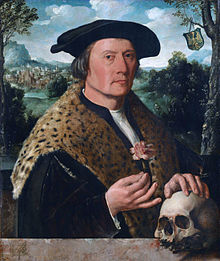Pompey Occo
Pompeius Occo (* probably 1483 ; † November 22, 1537 ) was a German-Dutch merchant and authorized representative of the Augsburg bank Fugger in Amsterdam .
Little is known about the origin of Occos. It is certain that he was raised from 1494 by his uncle, the Augsburg doctor and humanist Adolphus Occo (1447–1503), and after his death in 1503 he inherited the famous library of Rudolf Agricola , which Adolphus Occo had inherited from Agricola.
Occo, coming from Germany, settled in Amsterdam around 1510. His house Het Paradijs (“Paradise”) in the Kalverstraat was a meeting place for artists and intellectuals from all over Europe. He was also the banker of both the Archdiocese of Nidaros (today's Trondheim ) and King Christian II of Denmark . When the dispute between the king and Archbishop Erik Valkendorf escalated, the bishop fled to Amsterdam, where he went into hiding with his friend Occo for some time.
Valkendorf and Occo shared a passion for old books. The collection of the (now closed) Museum Enschedé in Haarlem contains an illuminated Norwegian Bible, a gift from Valkendorf to Occo. Pompey Occo also had an intermediary role in the production of the first printed books for Norway, a missal ( Missale Nidrosiense ) and a breviary ( Breviarium Nidrosiense ) for the Archdiocese of Nidaros. Another project that Valkendorf commissioned from the printer Doen Pieterszoon in 1520, namely an illustrated Passion booklet with woodcuts by Jacob Cornelisz. van Oostsanen , Lucas van Leyden and Jan de Cock, was never realized.
Sources and individual references
| personal data | |
|---|---|
| SURNAME | Occo, Pompey |
| ALTERNATIVE NAMES | Occo, Popius; Ochesz, Poppe; Otto, Popias |
| BRIEF DESCRIPTION | Dutch banker and wholesale merchant, humanist |
| DATE OF BIRTH | 1483 |
| DATE OF DEATH | November 22, 1537 |
